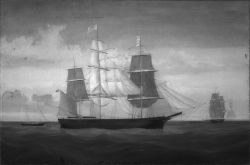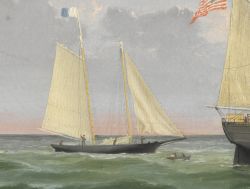loading 
Fitz Henry Lane
HISTORICAL ARCHIVE • CATALOGUE RAISONNÉ • EDUCATIONAL RESOURCE
An online project under the direction of the CAPE ANN MUSEUM
An online project under the direction of the CAPE ANN MUSEUM
Catalog entry
inv. 35
Portrait of the "National Eagle"
Ship "National Eagle"
1853 Oil on canvas 23 1/2 x 36 in. (59.7 x 91.4 cm) Signed and dated lower right: F H Lane 1853
|
Supplementary Images
Provenance (Information known to date; research ongoing.)
the Artist, Gloucester, Mass.
Francis Fisher
Marjory A. Johnson
Cape Ann Museum, Gloucester, Mass., December 15, 1988
Exhibition History
Cape Ann Historical Association, Gloucester, Massachusetts, Training the Eye and Hand: Fitz Hugh Lane and Nineteenth Century American Drawing Books, September 17, 1993–January 29, 1994.
Published References
Craig, James. Fitz H. Lane: An Artist's Voyage through Nineteenth-Century America. Charleston, SC: The History Press, 2006., pl. 15, Ship "National Eagle".


Commentary
The clipper ship “National Eagle” was built at Medford, Massachusetts, by Joshua T. Foster in 1852 for Fisher & Co. of Boston. Sailed in her first year in the “triangle run” between Boston, New Orleans, and Liverpool, she then made a passage of 134 days from Boston to San Francisco, returning to Boston via Calcutta. The result of this voyage led her owners to put her in the ice trade, taking ice to Calcutta and returning with mixed cargos. In 1863, her voyages between Boston and San Francisco were resumed with numerous extended voyages to other Pacific ports.
In 1865, “National Eagle” was sold to Bates, Holbrook & Candage of Boston, making voyages to numerous ports around the world, though not to any consistent trading route. Sold subsequently to two other shipping firms and registered in New York, she lasted until 1884, when she was wrecked in the Adriatic Sea while bound from New York to Fiume, Austria. Her life span, thirty-one years, was matched or exceeded by very few other clipper ships.
Lane’s painting depicts “National Eagle” outbound from Boston, hove-to with her main sails aback, waiting for the pilot schooner’s yawl boat to row over and pick up the pilot who guided her out of Boston Harbor. She will then proceed on her voyage. This broadside view comes as close as any other Lane vessel portrait in conforming to ship-portrait standards for shipping firms. Lane clearly was not interested in making formalized vessel portraits of ships posed broadside, with all sail set, close-hauled, and drawing perfectly. He constantly varied the settings, weather conditions, and likely situations that were realistic—sometimes threatening, but always depicting competent ship handling.
Lane also had an astute eye for weather and sea conditions. In this case, the fine weather in the foreground is threatened by an approaching front with cirrocumulus and altocumulus clouds leading a darkening bank of cumulonimbus clouds. “National Eagle” will probably have a summer warm front to weather on her maiden voyage to New Orleans.
– Erik Ronnberg